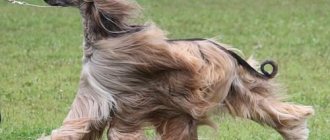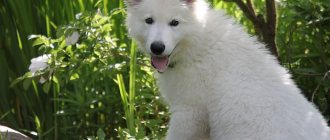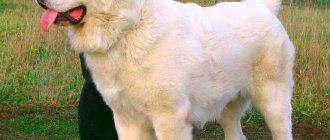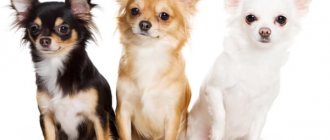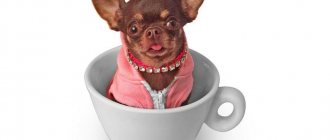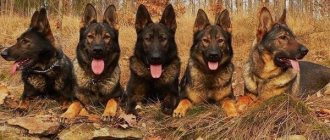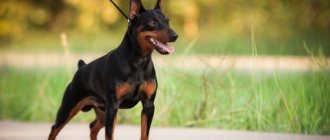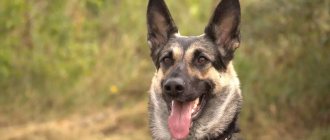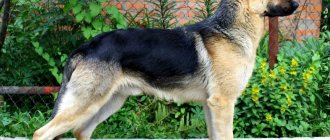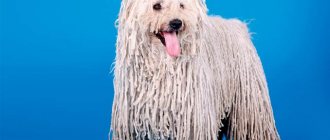The Shepherd is one of the most popular breeds of domestic dogs. She was bred as a shepherd's assistant - a shepherd - many centuries ago, when livestock had just been domesticated. The dog turned out to be smart, devoted, faithful and beautiful.
Today there is no need to protect every flock of sheep from attacks by predators, but sheepdogs are not becoming less popular. They are bred as human companions, loyal friends who help serve, brighten up loneliness or direct excess love to a living creature.
To date, more than 50 breeds of shepherd dogs have been bred. They are all very different in character and appearance. One has only to compare a big dog and a corgi!
In this article we will talk about the smallest shepherd dogs in the world, unique representatives of the breed. But small does not mean that they are stupid or easy to educate. Character is in the shepherd's blood.
Swiss, up to 50 cm
The Swiss Shepherd resembles a loyal white wolf. This is an incredibly beautiful dog up to 50 cm high with long snow-white hair.
This breed was developed in Switzerland. Its representatives resemble in appearance a German Shepherd, if they could be completely white. They are loyal, friendly and quite active, but less aggressive than their German relatives.
Such a dog is friendly towards people and is incredibly affectionate with children, and is friendly with cats and other pets. Swiss Shepherds do best in a country house, but can adapt to more cramped conditions.
English, up to 45 cm
The history of the breed goes back to the times of the Roman Empire, from where it came with the conquerors to good old England. There it was crossed with other dogs, the ancestors of the modern collie, and used as a herding breed.
The English Shepherd is a short dog, up to 45-50 cm at the withers. She has a strong, lean body, the most common color is white-black-tan, but the standard also provides for other options, for example, white-tan or white-red.
Like most herding breeds, it is quite independent, but prefers to work in a team with a person and receive commands and praise.
German hunting dogs
Hunting dogs are used both for their historical purpose and can become participants in exhibitions and pets. These include:
- Weimaraner. Initially, the breed was bred for hunting roe deer, wild boars, and bears. A little later they were reclassified as poultry.
- Bavarian mountain hound. Hunts roe deer, red deer, elk, mouflon, fallow deer, as well as hare and duck.
- Kurzhaar. They go hunting with dogs of this breed: pheasants, snipe, corncrakes, ducks, etc. In addition, they take them to hunt hare, wild boar, deer and fur-bearing animals.
- German Wachtelhund. The name of the breed literally translates as “quail dog.” Today, dogs of this breed are also trained to hunt deer, elk and wild boar (so-called blood trail hunting).
- Small Munsterlander. A versatile gun dog, capable of hunting on land and water, game birds and fur-bearing animals.
- German Stichelhaar. A cop, capable of working in any conditions, both on a “cold” and “blood” trail.
- Jagdterrier. Specialist in burrow hunting for badgers and foxes.
Croatian, up to 45 cm
These dogs are widespread throughout Croatia, but they are rarely seen outside its borders. She has a rather unusual appearance, especially in puppies, which look more like lambs than dogs. The fact is that this dog, with its muzzle and build typical of a shepherd dog, has brown curly hair.
Like any shepherd, the Croatian is smart, quick-witted, dexterous and agile. Despite her small height at the withers, she requires constant movement. And he cannot do without frequent communication with the owner.
How to choose a puppy
It is recommended to purchase Australian mini puppies only from nurseries that specialize in breeding this particular breed. A secret private purchase sometimes results in a dog that looks, but does not resemble, an Australian Shepherd.
In the first months of life, gullible laymen will easily confuse many furry “mutts” with a purebred Australian. In nurseries, puppies are sold no earlier than two months of age, when they are registered. Buyers are given a puppy card and a veterinary passport with the first vaccinations.
Icelandic, 45 cm
This strong miniature white and red dog immediately wins everyone's sympathy. She has thick fur, short paws and a curled fluffy tail - a definitely touching combination.
Meanwhile, this is a very hardy, smart and non-aggressive dog that has lived in Iceland for centuries. She arrived on the island along with the first settlers, the Vikings, around the first century AD, and survived side by side with people in harsh conditions.
This is a herding breed with all its inherent character traits. She has a loud bark, which is very useful when grazing livestock, but will interfere with establishing relationships with neighbors. Therefore, the Icelandic Shepherd with relative freedom and a lot of mobility.
Health
Australians were doomed to active physical labor in the fresh air; as a result of natural selection, the strongest and healthiest individuals survived, giving strong offspring. Thus, even the miniature Aussies, the successors of these herding dogs, enjoy good health.
Diseases
No one is immune from illness, and our younger brothers are no exception. The following diseases are typical for Mini-Australians (but not more often than in other related breeds):
- hip dysplasia.
- epilepsy;
- eye cataracts;
Many diseases can be prevented and treated with regular veterinary visits and vaccinations. Chemical preparations produced in the form of drops, tablets or applied to a special collar help against ticks and fleas.
Vaccinations
Timely vaccination keeps your pet healthy and alive. The first vaccinations according to the vaccination schedule are given to the puppy while it is still in the nest. These are vaccines against rabies, plague, enteritis. The new owner must adhere to this schedule, doing a booster every year.
Aussie, up to 45 cm
Aussie is another name for the Australian Shepherd . She has an elongated muzzle, triangular floppy ears and short legs. Although different colors are acceptable, the most common Aussies are white, black and tan, with some of the white fur covered in black spots, which together with blue eyes gives a very unusual combination.
Despite the name, which seems to hint at the place of origin, the USA is considered the birthplace of the Aussie. The dog is known for its good nature and tendency to learn, so it is often used to serve humans. However, make no mistake, her cheerful disposition does not prevent her from giving a worthy rebuff to the offender.
Maintenance and care
To maximize the life of a dwarf German shepherd, caring for it must be even more thorough than for a regular one. She needs regular walks (at least twice a day) and dosed physical activity. Thick fur is combed out to prevent tangles from forming. They clean their ears and teeth regularly, trim their nails if necessary, and bathe them once a month.
The dog's diet is composed so that the amount of fats, proteins and carbohydrates is balanced. Dry food is selected according to age, giving preference to brands with a high content of calcium and vitamin D. You should not overfeed a dwarf so that he does not develop obesity.
The pet must be regularly brought to the veterinarian for examination and all his recommendations must be strictly followed in order to maintain the dog’s health for many years.
Miniature American Shepherd, up to 45 cm
The miniature American Shepherd resembles an Aussie in appearance. This is not surprising, since it was bred in the 60s by crossing Australians with an unknown small dog. This was done not so much on a whim, but rather with the goal of reducing the size of the Aussies, but preserving their intelligence, service qualities and character traits.
The new breed was officially recognized in 2010. The American Shepherd turned out the way it was intended: miniature, but strong, hardy, with a good nervous system. The coat can be white and black, white and red, with or without tan marks, with or without white markings - in general, the dog has a wide variety of colors.
Marriage or breed
This type of shepherd is not a breed; it is not distinguished separately. Moreover, such small dogs are sterilized to prevent them from having offspring.
CAREFULLY!
Dwarfism is an absolute deviation from the norm. A dog with this defect requires more attention than a healthy one.
Such a dog can be born to healthy parents; it is impossible to predict the birth of a puppy with a deviation. Until a certain age, the puppy will not even differ from the other kids in the litter.
In the future, dogs may suffer from other diseases - hyperpigmentation, various bacterial infections, kidney failure, problems with the thyroid gland .
Therefore, dwarfism is not a cute feature - it is a serious violation of the normal functioning of the body. Such a dog needs special care and treatment.
At the first signs of the disease, the puppy needs a course of growth hormone injections. This will help avoid complications in the future.
Greek, up to 35 cm
This shepherd was bred in the mountainous regions of Greece to help shepherds look after their livestock. This is primarily a service dog, hardy and unpretentious. During training, consistency and rigor are required; the shepherd dog does not respond well to cruelty. But if a person is lucky enough to become a real master for her, then she will be faithful to him all her life.
The Greek Shepherd is a medium breed, it has a strong, muscular body, white, gray and black coat. The main goal was to obtain service qualities, so the color is not so important and the most diverse is found.
Sheltie, up to 35 cm
A Sheltie can easily be confused with a Collie - the two breeds are quite similar. But Sheltie, Shetland Sheepdog , is much smaller in size: height at the withers reaches 35 cm, weight 6-7 kg.
The homeland of the Sheltie is Scotland, more precisely, the Shetland Islands, where the Sheepdogs came with the first shepherd settlers. There, dogs freely crossed with Spitz dogs, inheriting their color and light coat.
Shelties are cheerful, good-natured and curious creatures, ready to get acquainted with any fauna that comes along the way. They love to bark loudly and provocatively, so those who like silence should think twice before making such a friend. The Sheltie is a very active breed and requires active and long walks.
History of appearance
Shepherds are the first “position” that shepherd dogs received from humans. They guarded the herds, making sure that no animal got lost and keeping predators away. This is how the qualities characteristic of all representatives of this breed were developed: courage, intelligence, strength, endurance, loyalty.
However, large dogs could not handle every job.
It was easier to protect small animals with a smaller dog: their large size could interfere with walking along those paths along which sheep and goats of small breeds could easily run. In addition, a small “shepherd” is always more profitable from an economic point of view: he will eat much less.
Thus, in different countries of Europe, several varieties of miniature herding breeds were formed, the representatives of which in their spirit were still the same brave and intelligent shepherd dogs, and were significantly inferior in size to other relatives. The following breeds are still known and popular:
- welsh corgi,
- Schipperke,
- dwarf Australian Shepherd,
- Sheltie
Schipperke, up to 30 cm
Miniature jet-black dogs invariably cause a lot of affection, but they are quite independent and proud dogs. They were bred in Belgium in the 19th century to hunt rats and mice.
Schipperke do not exceed 30 cm, weight ranges from 3-9 kg. The fur is black, shiny, triangular ears stand up, and the chest is decorated with a lush “collar”. Dogs cannot live normally without active communication, sports and frequent walks, so with homebodies and introverts they will only torment each other.
